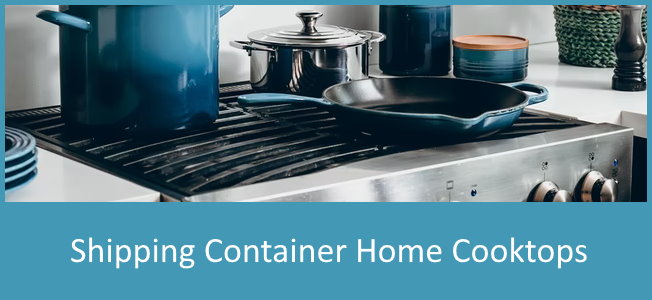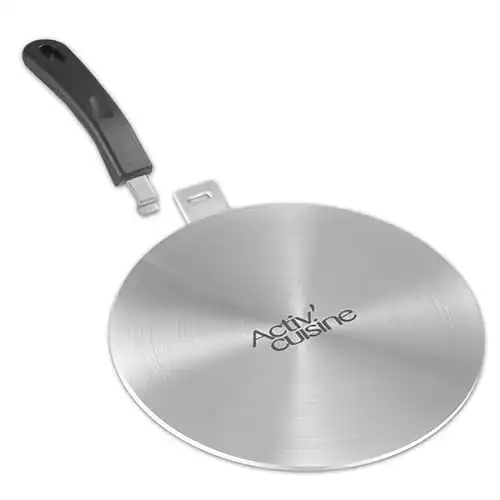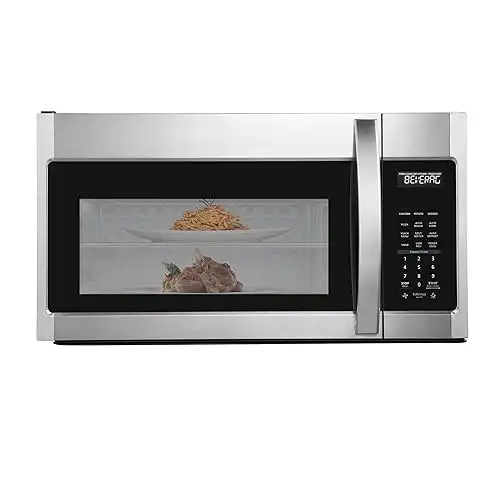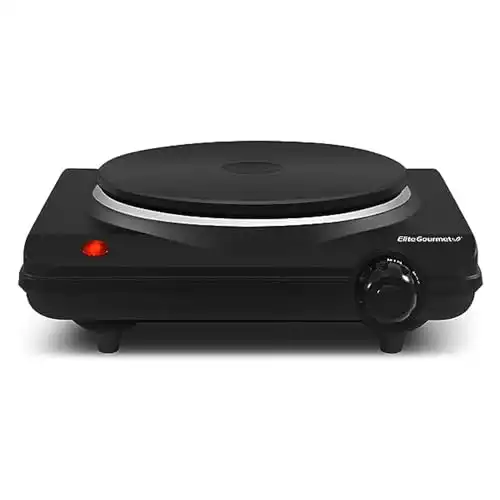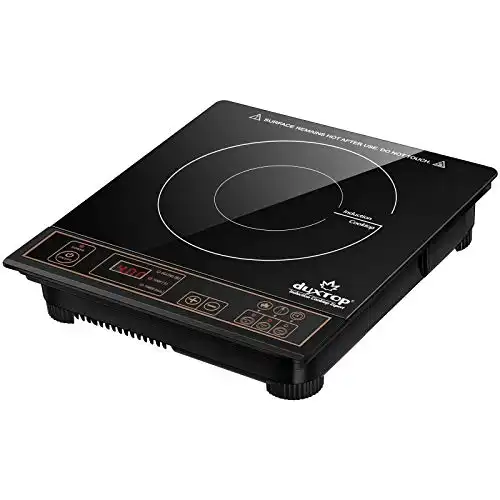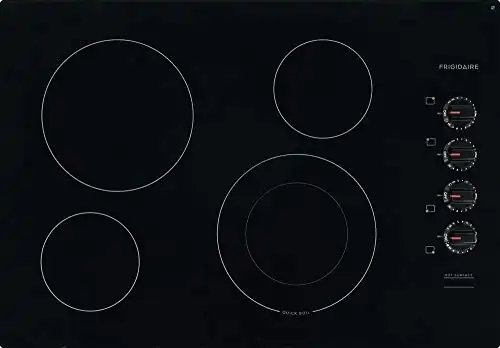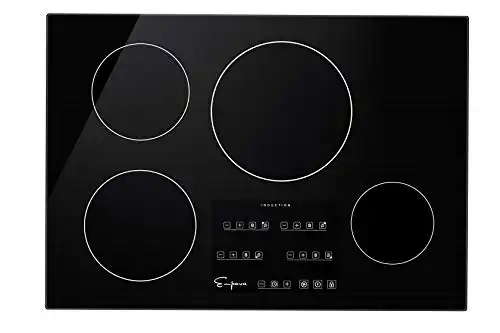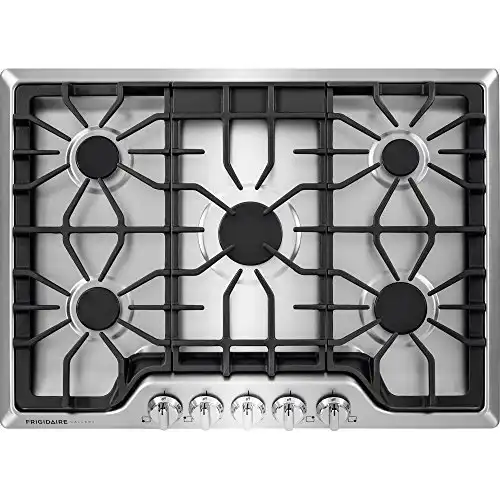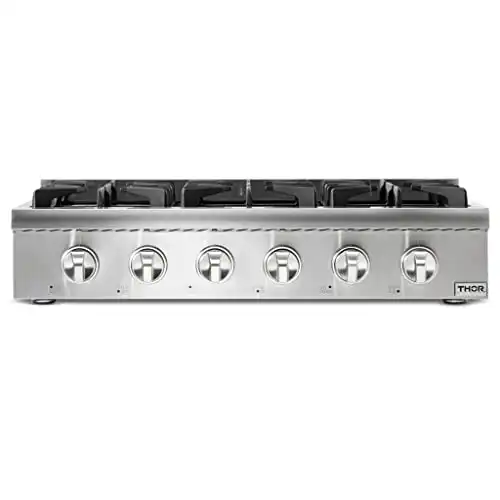The cooktop is arguably the simplest and most common cooking appliance in kitchens worldwide. A source of heat, a cooking container, and some food are all that’s needed. But there are a surprising amount of cooktop options available!
Should you use gas or induction? Do you need a ventilation hood? Will your fancy copper pans even work with the cooktop you selected?
In this article, we’ll answer these questions and many more as we deep dive into everything you need to know about kitchen cooktops. Whether you’re building a huge, commercial-style kitchen for your shipping container mansion or a tiny kitchenette for your container cabin, we have you covered.
What is a Cooktop?
A cooktop is an appliance that allows you to apply heat to the base of pots and pans. For our friends in countries that use British English, you may be more familiar with the term ‘hob’. Other terms like stovetop, countertop stove, and rangetop are essentially the same as a cooktop (we’ll discuss some subtle differences later).
Cooktops are small and simple compared to ovens. You could even argue that a few campfire coals placed under a cast-iron skillet create a primitive form of a cooktop, though we’ll be talking about more sophisticated setups here!
With a cooktop, all sorts of cooking possibilities open up. A few ways to utilize a cooktop are:
- Boiling: Cooking foods in a liquid (usually water) at its vaporization temperature. More information.
- Simmering: Similar to boiling, but at a temperature slightly below the boiling point, which is more gentle on the cooked foods. More information.
- Poaching: When food is cooked in a liquid bath, but at an even lower temperature than simmering. The intent is for the food to keep a similar structure and shape throughout the process, such as poaching an egg. More information.
- Stewing: Also involves food cooked in liquid, but with the intent of breaking down or softening foods to make them easier to eat and allow flavors from various ingredients to mix. Similar to Braising. More information.
- Frying: Cooking foods in hot oil or liquid fats of various depths. Varieties include Deep-frying, Stir-frying, Sauteing, etc. More information.
- Searing: A technique that uses a hot pan to quickly cook the surface of food (typically meat) and give it a crusty, brown texture. Closely related to Blackening and Browning. Carmelizing is somewhat similar, except it involves cooking the sugars rather than proteins of the foods. More information.
In many kitchens, the cooktop and oven are combined into one appliance, called a range. Most of our discussion of cooktops in this article applies to ranges as well, so there’s still plenty to learn whether you want these two appliances seperate or combined.
However, you may be wondering why would someone ever choose a cooktop when ranges are available. There are three primary reasons: appearance, comfort, and flexibility.
Appearance-wise, some people find that a separate cooktop provides a more luxurious look to a kitchen, perhaps because it’s commonly a more expensive option. The kitchen is a focal point of a home, and the appliances in the kitchen help ‘set the tone’ for visitors and prospective buyers about the luxuriousness and quality of the rest of the build.
Comfort is also a reason to choose a cooktop over a range. With a cooktop, you can choose exactly how high to place the cooking surface, using a dropped counter section for the cooktop to improve accessibility. It also means you can place your built-in oven higher in a cabinet than a range allows so that you don’t have to break your back bending over to insert and remove cookware.
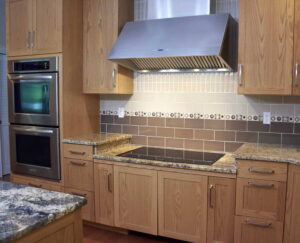
Furthermore, a cooktop can be placed in a completely different location in the kitchen from an oven, often on an island to create a better flow when cooking complex dishes or with multiple people in the kitchen. The vast majority of ranges have to be placed up against a wall because their controls are on a vertical surface behind the burners, so islands are off-limits.
Finally, there’s flexibility, which we define as the ability to choose the specifics of your oven and cooktop separately. Want two different brands, two different fuel types, or two different sizes?
By having a separate oven and cooktop, you have the option to make these choices independently. It also allows you to replace each appliance individually if/when necessary, which may help save you money in the future.
What’s Unique about Cooktops for Shipping Container Homes?
Nothing is especially unique about cooktops for container homes. The cooktops work the same way, regardless of the construction of the home around them.
However, if by container homes you’re implying a tiny home, then yes, smaller cooktops are available and worth investigating. We’ll cover some of these options later.
One other important point to note is related to container home condensation. More so than with many other types of traditional construction, condensation can be a problematic issue for shipping container construction. And as our article on container condensation discusses, a large part of handling condensation is limiting sources of moisture in your home. For this reason, cooktop ventilation (discussed later in the article) is an area to really pay attention to.
The introduction to this article referenced the fact that there are quite a few cooktop options available for consumers. Below, we’ll discuss many of these options, broken up into categories like placement, size, and heat source.
Placement Options for Cooktops
The placement of a cooktop primarily dictates how it is installed and how it is controlled. The first option is a countertop cooktop.
For this type of cooktop, you’re placing the appliance onto, not into the counter. In other words, the cooktop is portable. You can keep the cooktop in a drawer or cabinet when not in use.
Many people use the term hot plate for countertop cooktops, especially if they are small. You may also hear the term camp stove, which is a cooktop typically reserved for outdoor use while camping.
A countertop cooktop is usually comparatively small, often with only one or two burners. Due to their small size, they are usually able to be powered with a 110V outlet. It’s great for a kitchenette or tiny container kitchen, but most full-size kitchens will have one of the two main types of built-in cooktops with a larger 220V electrical power requirement.
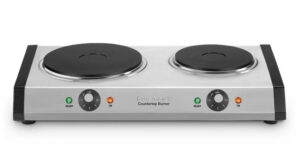
Built-in cooktops are permanently installed into a cutout in the countertop. Some are placed in a hole in the counter, with the controls on the horizontal surface of the appliance. These are often called ‘drop-in’ cooktops.
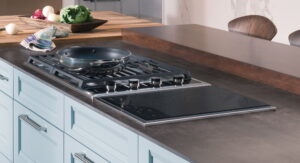
Other cooktops are placed in a gap in the counter that extends across its width. These are often called rangetops. Rangetops slide into the cabinetry from the front and have their controls on the front, vertical surface of the unit. They’re often available in larger sizes and are sometimes available with added features like griddles and grills.
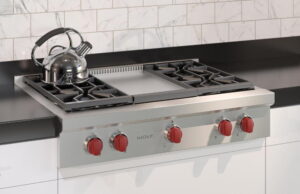
Regardless of whether you choose a drop-in cooktop or rangetop, you’re getting a sleeker, more luxurious look for your kitchen. You also have the benefit of a seamless countertop, with no cracks where spills and crumbs can fall like on the border between a range and adjacent counter space.
Cooktop Sizes
The size of your cooktop will affect not only how much food you can cook at one time, but also how much kitchen space you’ll need to dedicate to housing the appliance. Selecting the right size is therefore a function of both your overall home design and your cooking plans.
The three factors you need to focus on are the unit width and the number and size of burners. While portable units often measure width horizontally (two burners would be placed side by side), built-in units usually measure width vertically (two burners are placed in line, one in front of the other). Standard built-in cooktops are often found in 30-inch and 36-inch widths, though options as narrow as 12 inches and as wide as 48 inches can commonly be sourced.
The amount of counter space you have will determine how much width you have available, and your cooking needs will determine how many burners of which size you require. Cooktops are usually available with anywhere from one to six burners, often in two sizes to fit a variety of cookware.
While many homes in western countries typically have a four-burner cooktop (sometimes with four equal burners, and other times with two small and two large burners), most at-home cooks rarely use more than two burners at a time. Does this apply to you as well?
Think through some of your typical meals and envision how you cook them. Some people even create a written log for a few weeks, just to help them remember.
For instance, do you often boil pasta and simmer sauce at the same time, or do one after the other? Spending some time mentally preparing a meal will help you narrow down how many burners you might use simultaneously, and of which size. This exercise may prove to you that a smaller cooktop than you imagined will meet all of your needs, saving you both money and kitchen space.
Consumers often size appliances and even whole rooms based on rare events, like preparing a holiday meal. If you only need four burners twice a year, maybe another solution for these infrequent times would be better and more economical for your household. For more information on this line of thinking, definitely check out our article on container home affordability where we discuss needs versus wants in home design.
Cooktop Heat Source Options
The last way we’ll differentiate the numerous cooktop varieties is by their heat source. While there are some obscure choices like wood-fired and oil-burning, let’s spend our efforts here on the three major cooktop heat sources: gas burner, electrical resistance, and electrical induction.
Gas Burner Cooktop Overview
A gas-powered cooktop is just what you expect: cooking over an open flame provided by a gaseous hydrocarbon. We actually have a great introduction to fuel gas in our article on water heaters, so check that out first to get up to speed on some of the subtleties of different fuels like propane and natural gas.
Benefits of Gas Cooktops
- Seamless move between low and high heat with the quick turn of a nob that provides an infinite amount of intermediate temperatures. The size of the flame makes it easy to know visually how hot the burner is.
- Heat up rapidly so you can start cooking quickly.
- Works even when the power is out, such as in a heavy storm (though this may require manual lighting with a match if the electrical ignitors won’t work).
Downsides of Gas Cooktops
- Requires the installation of a tank or the presence of gas utility service, which isn’t available everywhere.
- Emits greenhouse gases that are bad for the environment, diminish indoor air quality, and can cause human health impacts.
- If left and on and unlit, can cause dangerous gas leaks (though newer models often have automatic shut-off valves to prevent this).
- Don’t offer a smooth cooking surface and thus can result in more time for cleanup after cooking.
Electrical Resistance Cooktop Overview
Electric resistance burners are the most common type of cooktop, historically speaking. They work by using electrical resistance heating elements made into flat coils. For more information on how they work, check out our article on ovens which has a great section on electrical heating elements.
These electric coils transmit heat to your pots and pans via both conduction and radiation, so a clean surface on the bottom of your cookware is important. They are available in a variety of power ratings, often from 1000 watts to 5000 watts, which will affect the time needed to heat large cookware.
There are two main types of electrical resistance cooktops which we’ll call coil and ceramic:
- Coil: The cheapest option, which uses an exposed heating element that your pots and pans sit directly on top of while cooking.
- Ceramic: Essentially, a coil heating element that is placed underneath a high-temperature ceramic glass creates a smooth, modern-looking cooking surface and allows for easier cleanup. You may see these referred to as smooth tops, glass tops, radiant cooktops, etc.
Benefits of Electrical Resistance Cooktops
- Affordable to purchase.
- Popular and thus easy to source.
Downsides of Electrical Resistance Cooktops
- About 74% efficiency (Source).
- Slow response time and residual heat lag when adjusting the power knob and seeing the corresponding cooking power move up or down.
Electric Induction Cooktop Overview
Induction Cooktops are the new kids on the block, entering the world of cooking just a few decades ago thanks to some innovative technology. They have rapidly gained adoption in many countries, though they are still relatively unknown by many in the United States.
Underneath their smooth tops are sophisticated electronics that apply an alternating current (AC) to a coil of copper wire, which creates a magnetic field that is absorbed by the cooking vessel above. This oscillating magnetic field heats up the cookware directly, without using conduction or thermal radiation, and without unnecessarily heating the smooth top of the unit. Much like with electric resistance cooktops, electric induction cooktops are offered in several power outputs (measured in watts) that will dictate your cooking times.
Benefits of Electrical Induction Cooktops
- The most energy-efficient option, about 90% efficiency (Source)
- Rapidly changes heat output with no lag, and can turn off almost immediately.
- The cooking surface is much cooler to the touch for added safety.
- Easier to clean because the smooth cooking surface is kept cooler, so spilled foods don’t ‘bake on’ as much as with ceramic electrical resistance cooktops.
Downsides of Electrical Induction Cooktops
- More expensive than electrical resistance cooktops.
- Creates a humming noise from the oscillating magnetic field that some people find annoying.
- Require magnetic cookware, so cookware made from things like copper and aluminum won’t work. You can check by seeing if a magnet sticks to the bottom of your pot or pan.
There is one relevant thing to highlight if your existing cookware isn’t magnetic. So-called induction interface disks (also called induction converter disks or hob diffusers) can work to essentially transform your induction cooktop into a hotplate with a magnetic disk that fits between the cooktop and your cookware. This is an inefficient option and using the correct cookware is much more ideal, but one of these disks might be a good stopgap solution for you:
Cooktop Ventilation Requirements
Regardless of the cooktop you select, ventilation is something you need to consider. Cooking, especially in open pots and cans, can release smoke, vapor, and odors into the surrounding air.
As previously mentioned, water vapor that comes as a result of boiling is of significant concern for shipping container homes. It raises the relative humidity indoors and can be a contributor to condensation.
Therefore, when using a cooktop, a dedicated form of ventilation is best (and is often required by local building codes, if they apply to your project). Note that ductless/recirculating ventilation systems are insufficient: they filter the air of grease and particulates, but don’t exhaust the water vapor.
The most common type of cooktop ventilation is called a vent hood and is a simple fan attached to a ‘hood’ over the cooktop surface. These provide the highest flow rate of air for those who cook a lot, but they can take up a lot of room.
If you do choose to go with a vent hood, one variety is actually built into the bottom of a microwave (and commonly called an over-the-range microwave, despite the fact that it can also be used over a cooktop). These look clean but may result in the microwave being placed too high in your cabinetry, depending on your height.
And, because they combine two appliances into one, they are more complex and therefore costlier to repair despite saving precious room in your kitchen. Finally, they have a reduced flow rate of air compared to an individual vent hood. Below is one example of a combined microwave and vent:
The other main choice for cooktop ventilation is downdraft ventilation. This ventilation system s]is integrated into the countertop (and often, the cooktop itself) to pull the rising air back down into a vent. Downdraft ventilation systems are especially good for locations where an overhead vent hood would be unsightly or difficult to place. One caveat to note is that because downdraft ventilation is fighting against the air’s natural tendency to rise, it is less effective than vent hoods, especially with taller pots.
A final point to consider is that of makeup air. With homes that are especially ‘tight’ like container homes (meaning they don’t leak much air through cracks, wall penetrations, etc.), you may need to ‘find’ air to replace what is exhausted through the vent. If you add a comparatively large ventilation system to your cooktop, it’s worth doing some research into make-up air, and this article from Fine Homebuilding is a great introduction.
Best Cooktops for Shipping Container Homes
Below are several of our favorite container home cooktops covering a variety of combinations of placement, heat source, and size. We don’t cover every possible configuration but instead focus on the most popular choices. If, for example, you see a model you like but wish it was a little larger, know that many manufacturers make similar models in multiple sizes.
Best Single Burner Electrical Resistance Cooktop – Elite Gourmet ESB-301BF
Built of sturdy aluminum, this very affordable electrical resistance hot plate gets the job done with few frills. The adjustable knob covers warm, low, medium, and high settings, probably enough for most cooking simple meals. With only 1000 watts of power and a small 6.4 inch diameter heating plate, you’ll need to stick to smaller cookware. But this would be a great way to outfit a tiny, minimalist container cabin.
Dimensions: 10.65 x 9.15 x 3.65 inches
Best Single Burner Countertop Electrical Induction Cooktop – Duxtop 8100MC/BT-180G3
A lot of people have questions and concerns about moving to an induction cooktop, but this very highly reviewed single burner induction hotplate will let you start cooking the induction way for cheap. The sleek black finish, LED display, and push-button controls make it look more sophisticated than its affordable price would have you think.
With only a single burner, this unit can still function on a 120V outlet (though it needs a 15amp circuit). It offers from 200 to 1800 watts of power, corresponding to between 140 °F to 460 °F. There are also several safety features in place, like a auto-shut off if no cookware is detected, and both low and high voltage warning systems.
Dimensions: 13 x 11.5 x 2.5 inches
Best Four Burner Built-In Electrical Resistance Cooktop – FFEC3025UB
If you’re committed to a traditional electrical resistance cooktop but need a larger, four-burner model, this is a good option for you. At 30 inches wide, it’s still fairly compact despite it’s ample amount of cooking area.
As with most other large electric cooktops, this one requires 240V service and has a total power of 7900W across all the burners. As with all cooktops of this class, it has a ceramic glass cooktop that protects the resistance burners underneath and provides the sleek appearance.
Dimensions: 30.63 x 2.63 x 21.13 inches
Frigidaire FFEC3025UB 30 Inch Electric Smoothtop Style Cooktop with 4 Elements in Black
$699.00
$545.99
We earn a commission if you make a purchase, at no additional cost to you.
04/25/2024 12:40 am GMT
Best Four Burner Built-in Electrical Induction Cooktop – Empava IDC30
Ready to embrace induction cooking with a large kitchen cooktop? This model is a great choice.
It has a comparatively compact 30-inch frame that holds four heating elements sized from 6 inches to 10 inches in diameter. Using a 240V supply, it provides up to 7400W of cooking power across its burners.
Standard for an induction cooker are the digital controls, timer, and ceramic glass cover.
Dimensions: 30 x 21 x 2.12 inches
Best Gas Built-In Cooktop – Frigidaire FGGC3047QS
For some people, despite the attraction of induction cooking, the power and control of gas are hard to resist. Newer gas cooktops like this one look at place in a modern kitchen and have better features and cleanup than the gas burners of old.
Like the above electric models, this drop-in gas cooktop is a svelt 30 inches wide but still manages to fit in five total burners thanks to the compact, angled control panel near the front of the unit. The largest burner in the middle of the unit can actually go all the way up to 18,000 BTU for your largest pots of stew. And as you’d expect, this model has reliable electronic ignition, easily washable cast-iron grates, and a beautiful stainless steel base that will blend well with other stainless steel appliances.
Dimensions: 30 x 4.25 x 21.75 inches
Best Gas Slide-in Rangetop – Thor HRT3618U
Finally, for those who want the power of gas in a professional-quality unit, there is this Thor rangetop. Remember from our previous discussion that rangetops slide in from the front, meaning their controls are on the front of the unit instead of the top.
Being a pro appliance, this rangetop is the wider 36-inch size and has six powerful burners laid out in a perfect grid. The burners range between 18,000 and 12,000 BTU depending on their location.
Features include strong cast-iron grates, a stainless steel base, a black porcelain drip pan to aid in cleaning, and auto reignition to prevent gas from escaping an extinguished burner. This particular model is natural gas only.
Dimensions: 36 x 28.38 x 8.72 inches
Summary
For a long time, your choices in cooktops were basic electric resistance or gas. But now, technology has improved the functionality of gas and introduced induction cooking. It creates a lot of choices for a prospective container homeowner, but also a lot of opportunities.
Through this article, we’ve explored how to combine your preferences on size, positioning, and heat source into the perfect cooktop for your home. And we’ve also explored the subtleties of how those choices will impact your design and lifestyle.
It’s our sincere hope that you are now well-equipped to make an educated decision about your next kitchen’s cooktop to be as functional and economical as you desire.

